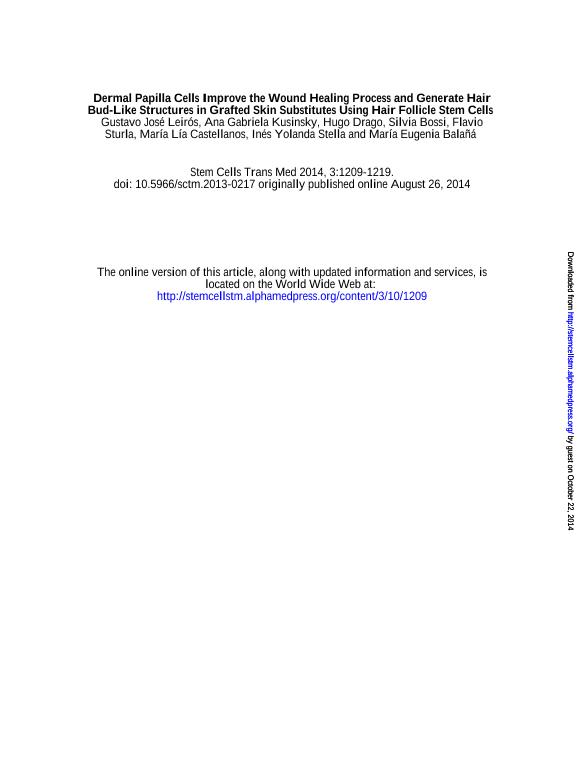Mostrar el registro sencillo del ítem
dc.contributor.author
Leiros, Gustavo Jose
dc.contributor.author
Kusinsky, Ana Gabriela
dc.contributor.author
Drago, Hugo
dc.contributor.author
Bossi, Silvia
dc.contributor.author
Sturla, Flavio
dc.contributor.author
Castellanos, Maria Lia
dc.contributor.author
Stella, Inés Yolanda
dc.contributor.author
Balaña, Maria Eugenia

dc.date.available
2016-02-10T19:05:38Z
dc.date.issued
2014-08
dc.identifier.citation
Leiros, Gustavo Jose; Kusinsky, Ana Gabriela; Drago, Hugo; Bossi, Silvia; Sturla, Flavio; et al.; Dermal Papilla Cells improve the wound healing process and generate hair bud-like structures in grafted skin substitutes using Hair Follicle Stem Cells; Alphamed Press; Stem Cells Translational Medicine; 3; 10; 8-2014; 1209-1219
dc.identifier.issn
2157-6564
dc.identifier.uri
http://hdl.handle.net/11336/4110
dc.description.abstract
Tissue-engineered skin represents a useful strategy for the treatment of deep skin injuries and may contribute to the understanding of skin regeneration. The growth of hair follicles in vitro or after grafting remains a major challenge. The dermal-epidermal composites are skin substitutes comprised of dermal fibroblasts (DF) embedded in a matrix overlaid with keratinocytes. Hair Follicle Stem Cells (HFSC) contribute to hair follicle regeneration and wound repair. Dermal papilla cells (DPC) signaling orchestrates hair follicle morphogenesis and regeneration. The use of DPC as dermal component in a permanent composite skin with human HFSC was evaluated by studying tissue-engineered skin architecture, stem cell persistence and hair regeneration as well as the graft-take in nude mice. A porcine acellular dermal matrix (ADM) was seeded with HFSC alone and with human DPC or DF. Histological and immunohistochemical analyses of in vitro constructs were performed. The presence of DPC induced a more regular and multi-layered stratified epidermis with more basal p63-positive cells and invaginations. Graft-take and tissue remodeling in nude mice were favored in DPC-containing composite skin supported by the fact of graft-epidermis survival and early neovascularization. Interestingly, only in grafted constructs containing DPC, embryonic hair bud-like structures were observed from 14 days after grafting. These structures showed cells of human origin, presence of precursor epithelial cells and expression of a hair differentiation marker. These observations suggest an incipient hair follicle neogenesis inside the remodeling ADM. Taken together our results show DPC and HFSC as promising cellular components for a permanent skin substitute.
dc.format
application/pdf
dc.language.iso
eng
dc.publisher
Alphamed Press

dc.rights
info:eu-repo/semantics/openAccess
dc.rights.uri
https://creativecommons.org/licenses/by-nc-sa/2.5/ar/
dc.subject
Skin Substitutes
dc.subject
Dermal Papilla Cells
dc.subject
Hair Follicle Neogenesis
dc.subject
Hair Follicles Stem Cells
dc.subject.classification
Otras Biotecnologías de la Salud

dc.subject.classification
Biotecnología de la Salud

dc.subject.classification
CIENCIAS MÉDICAS Y DE LA SALUD

dc.title
Dermal Papilla Cells improve the wound healing process and generate hair bud-like structures in grafted skin substitutes using Hair Follicle Stem Cells
dc.type
info:eu-repo/semantics/article
dc.type
info:ar-repo/semantics/artículo
dc.type
info:eu-repo/semantics/publishedVersion
dc.date.updated
2016-03-30 10:35:44.97925-03
dc.journal.volume
3
dc.journal.number
10
dc.journal.pagination
1209-1219
dc.journal.pais
Estados Unidos

dc.journal.ciudad
New York
dc.description.fil
Fil: Leiros, Gustavo Jose. Consejo Nacional de Investigaciones Científicas y Técnicas. Oficina de Coordinación Administrativa Parque Centenario. Instituto de Ciencias y Tecnología "Dr. Cesar Milstein"; Argentina
dc.description.fil
Fil: Kusinsky, Ana Gabriela. Consejo Nacional de Investigaciones Científicas y Técnicas. Oficina de Coordinación Administrativa Parque Centenario. Instituto de Ciencias y Tecnología "Dr. Cesar Milstein"; Argentina
dc.description.fil
Fil: Drago, Hugo. Hospital de Quemados de la Ciudad de Buenos Aires. Banco de Tejidos; Argentina
dc.description.fil
Fil: Bossi, Silvia. Hospital de Quemados de la Ciudad de Buenos Aires. Banco de Tejidos; Argentina
dc.description.fil
Fil: Sturla, Flavio. Hospital de Quemados de la Ciudad de Buenos Aires. Banco de Tejidos; Argentina
dc.description.fil
Fil: Castellanos, Maria Lia. Consejo Nacional de Investigaciones Científicas y Técnicas. Oficina de Coordinación Administrativa Parque Centenario. Instituto de Ciencias y Tecnología "Dr. Cesar Milstein"; Argentina
dc.description.fil
Fil: Stella, Inés Yolanda. Universidad Maimónides. Centro de Estudios Biomédicos, Ambientales y Diagnóstico; Argentina
dc.description.fil
Fil: Balaña, Maria Eugenia. Consejo Nacional de Investigaciones Científicas y Técnicas. Oficina de Coordinación Administrativa Parque Centenario. Instituto de Ciencias y Tecnología "Dr. Cesar Milstein"; Argentina
dc.journal.title
Stem Cells Translational Medicine
dc.relation.alternativeid
info:eu-repo/semantics/altIdentifier/issn/http://dx.doi.org/10.5966%2Fsctm.2013-0217
dc.relation.alternativeid
info:eu-repo/semantics/altIdentifier/url/https://academic.oup.com/stcltm/article/3/10/1209/6388150
Archivos asociados
